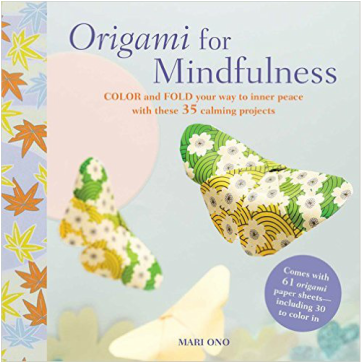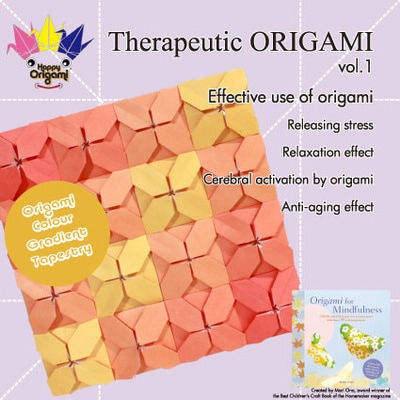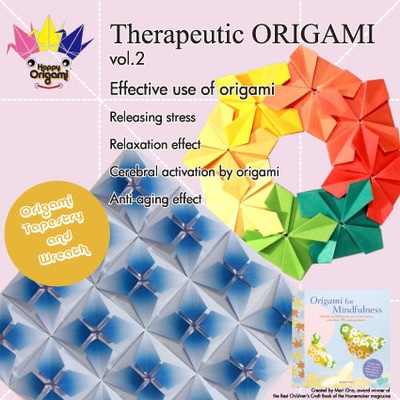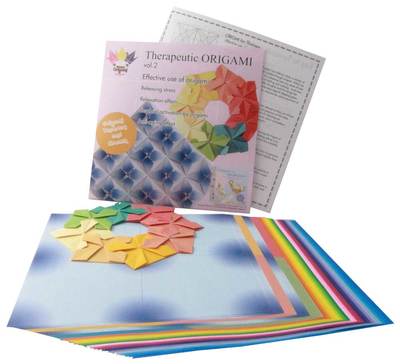Therapeutic ORIGAMI with Happy Origami Paper

ORIGMI for Therapy
-Effective use of origami-
When thinking of origami, I believe many people outside the East consider it just as child’s play activity. In recent years, however, a variety of effective uses have come to the fore. Like the recent phenomenon of ‘adult colouring books for relaxation’ we can gain unexpected benefits, which go beyond the field of play. It has quite impactful effects on our body, for example stimulating brain activity and its therapeutic effect can help us relax and heals our mind. So what are these effects specifically?
Releasing stress
Through the process of folding a piece of paper one fold at a time, a variety of shapes such as animals and flowers can be created through origami. When we are working on the creation of our models, we sometimes lose any sense of time and become totally enthralled in the process of folding and creating. Such time allows us to free our mind from external worldly thoughts and this brings the effect of releasing stress. Origami for adults is an easy way of releasing stress which doesn’t require any tools, or medication, and can be can be done anywhere at little cost.
Relaxation effect
The majority of adults these days have less time to be relaxed as they are always busy, multi-tasking and dealing with so many external pressures of life today. Origami can bring them total relaxation in no time at all, blocking out extraneous issues. Selecting their paper in their favourite colour and pattern, then folding it, one fold at a time, can release their tension.
Cerebral activation by origami
There are many nerves in the tips of our fingers. Because the nerves are linked to our brain, it is said that moving the fingers of both hands is the best way of training our cerebrum. Using the tips of our fingers by doing origami paper folding allows us to activate the brain and it is one of the most suitable recreational activities to allow us to keep the brain active and live live a healthy lifestyle.
The objective of working with origami is to fold it while ‘thinking, enjoying and imagining what it is going to be, how it is going to turn out.’ I have heard that we can’t expect the brain activation effect from just moving the tips of our fingers. Recent studies have found that doing origami activity while thinking of “what it’s going to be…” results in the brain activation.
In an investigation by Gakken Institute for educational general research in Japan, it was found that the level of brain activation by the movement of our fingertips when folding origami paper is quite high. It is even higher than doing puzzles and playing chess where we also use our fingers. According to their investigation, the third most effective activity involved the kendama (a traditional Japanese skill toy), the second most effective was doing calculation drills and the most effective was origami. They found that the work of folding origami paper increased the volume of blood flow in the brain the most. It has also been acknowledged that it is effective for patients in the early stages of dementia, thereby keeping the brain cells active.
Anti-aging effect
Nowadays, at hospitals and care centres all over Japan, origami has been introduced into the care programmes for patients to encourage cerebral activation and well-being. This is because when they are folding origami paper, the brain activation mode becomes high and similarly when they are creating something, the concentration mode becomes high.
This type of work, where people can visually enjoy a variety of colours and create cranes, airplanes, flowers and so on while moving their fingertips, also requires them to remember the process of folding. Using a variety of brain functions by, for example, checking the balance at each stage of the folding process or choosing a good colour to present the sense of seasons, for example, has been proven to be very effective in reducing the chances of developing dementia.
It is also possible to change the level of difficulty of the work according to the level of fingertip movement. Furthermore, at home or at the care centres, people can discuss the work that they have created with family members or friends, as well as care staff, and show the works they have made to each other. This encourages and activates positive levels of communication.
Origami which increases our creativity and joy
The impact of origami don’t just end on completion of a piece of work; it also expands to, for example, thinking of the shape and colour of the work (flowers, animals, insects, vehicles, foods, small items and so on), arranging a place to put it and imagining and designing how we can finish the final work, for example. Expanding our creativity allows us to acquire a sense of accomplishment and satisfaction, and the joy enriches our heart and self esteem. In fact, people who teach at an origami workshop often say that looking at the participants’ completed works is a moment of bliss.
As author of a range of books on origami I regularly receive a variety of messages and feedback: Here are just a few:
“I didn’t know how deep the origami was”; “Origami brought me happiness”; “So much fun”; “I feel brighter”; “It makes me excited”; “I can spend a day having fun”, “I can get motivated” and “I became less depressed”. We know first hand that it has a very good effect on our mental side. So let’s all train our brain with origami , relax and have fun too.
-Effective use of origami-
When thinking of origami, I believe many people outside the East consider it just as child’s play activity. In recent years, however, a variety of effective uses have come to the fore. Like the recent phenomenon of ‘adult colouring books for relaxation’ we can gain unexpected benefits, which go beyond the field of play. It has quite impactful effects on our body, for example stimulating brain activity and its therapeutic effect can help us relax and heals our mind. So what are these effects specifically?
Releasing stress
Through the process of folding a piece of paper one fold at a time, a variety of shapes such as animals and flowers can be created through origami. When we are working on the creation of our models, we sometimes lose any sense of time and become totally enthralled in the process of folding and creating. Such time allows us to free our mind from external worldly thoughts and this brings the effect of releasing stress. Origami for adults is an easy way of releasing stress which doesn’t require any tools, or medication, and can be can be done anywhere at little cost.
Relaxation effect
The majority of adults these days have less time to be relaxed as they are always busy, multi-tasking and dealing with so many external pressures of life today. Origami can bring them total relaxation in no time at all, blocking out extraneous issues. Selecting their paper in their favourite colour and pattern, then folding it, one fold at a time, can release their tension.
Cerebral activation by origami
There are many nerves in the tips of our fingers. Because the nerves are linked to our brain, it is said that moving the fingers of both hands is the best way of training our cerebrum. Using the tips of our fingers by doing origami paper folding allows us to activate the brain and it is one of the most suitable recreational activities to allow us to keep the brain active and live live a healthy lifestyle.
The objective of working with origami is to fold it while ‘thinking, enjoying and imagining what it is going to be, how it is going to turn out.’ I have heard that we can’t expect the brain activation effect from just moving the tips of our fingers. Recent studies have found that doing origami activity while thinking of “what it’s going to be…” results in the brain activation.
In an investigation by Gakken Institute for educational general research in Japan, it was found that the level of brain activation by the movement of our fingertips when folding origami paper is quite high. It is even higher than doing puzzles and playing chess where we also use our fingers. According to their investigation, the third most effective activity involved the kendama (a traditional Japanese skill toy), the second most effective was doing calculation drills and the most effective was origami. They found that the work of folding origami paper increased the volume of blood flow in the brain the most. It has also been acknowledged that it is effective for patients in the early stages of dementia, thereby keeping the brain cells active.
Anti-aging effect
Nowadays, at hospitals and care centres all over Japan, origami has been introduced into the care programmes for patients to encourage cerebral activation and well-being. This is because when they are folding origami paper, the brain activation mode becomes high and similarly when they are creating something, the concentration mode becomes high.
This type of work, where people can visually enjoy a variety of colours and create cranes, airplanes, flowers and so on while moving their fingertips, also requires them to remember the process of folding. Using a variety of brain functions by, for example, checking the balance at each stage of the folding process or choosing a good colour to present the sense of seasons, for example, has been proven to be very effective in reducing the chances of developing dementia.
It is also possible to change the level of difficulty of the work according to the level of fingertip movement. Furthermore, at home or at the care centres, people can discuss the work that they have created with family members or friends, as well as care staff, and show the works they have made to each other. This encourages and activates positive levels of communication.
Origami which increases our creativity and joy
The impact of origami don’t just end on completion of a piece of work; it also expands to, for example, thinking of the shape and colour of the work (flowers, animals, insects, vehicles, foods, small items and so on), arranging a place to put it and imagining and designing how we can finish the final work, for example. Expanding our creativity allows us to acquire a sense of accomplishment and satisfaction, and the joy enriches our heart and self esteem. In fact, people who teach at an origami workshop often say that looking at the participants’ completed works is a moment of bliss.
As author of a range of books on origami I regularly receive a variety of messages and feedback: Here are just a few:
“I didn’t know how deep the origami was”; “Origami brought me happiness”; “So much fun”; “I feel brighter”; “It makes me excited”; “I can spend a day having fun”, “I can get motivated” and “I became less depressed”. We know first hand that it has a very good effect on our mental side. So let’s all train our brain with origami , relax and have fun too.




